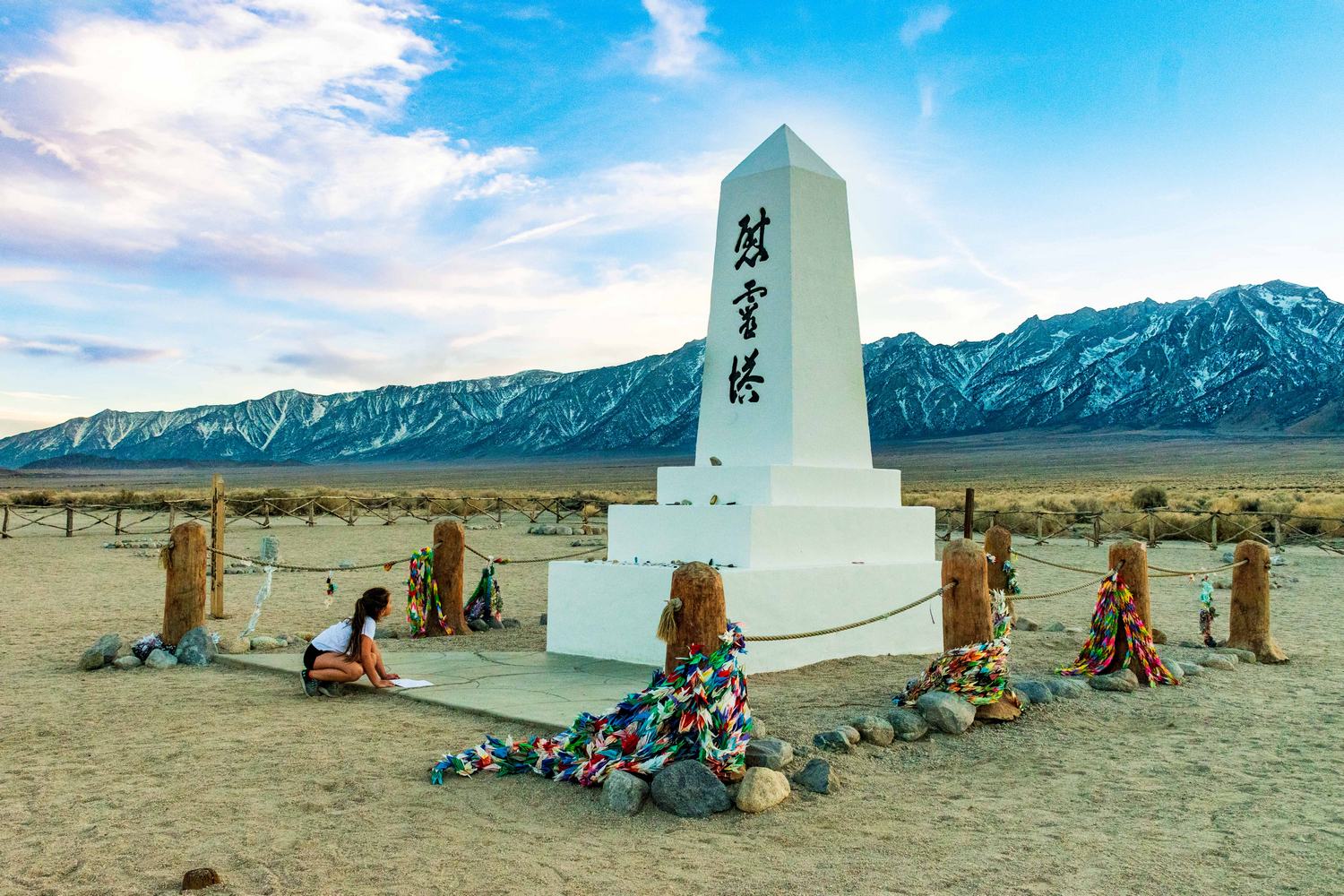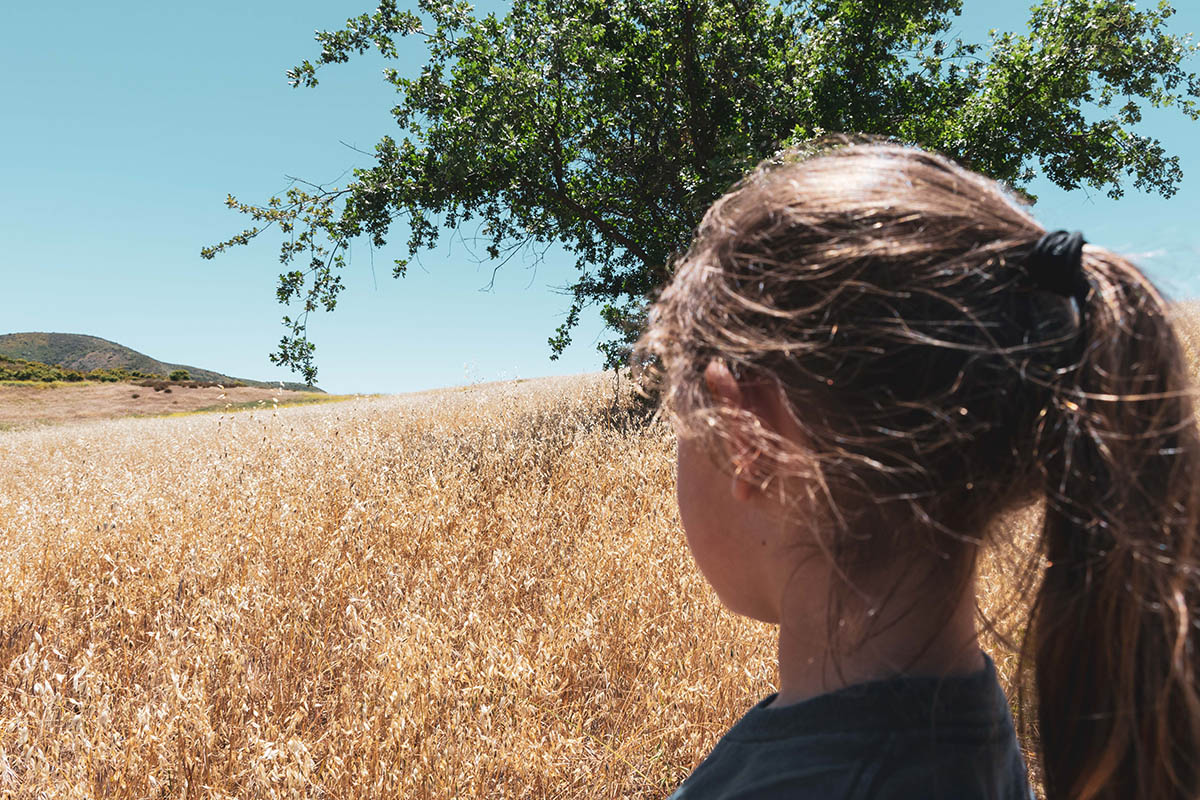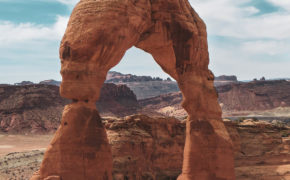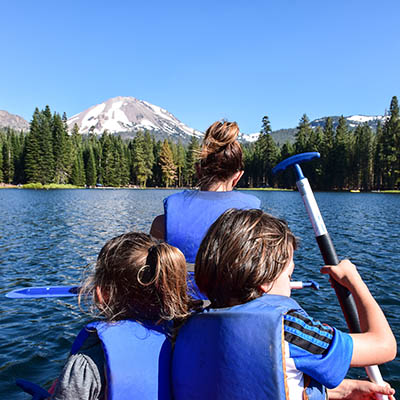VISITING MANZANAR NATIONAL HISTORIC SITE
Nestled against the Eastern Sierra range, with snow capped mountains peering down from above and a brisk wind sweeping through, sits the Manzanar National Historic Site. While, this may sound like a spectacular spot for a vacation; sadly, this is where a very dark time in our US history has been preserved for the education of generations to come. To ensure something of this nature never happens again.
Manzanar War Relocation camp is an area north of Lone Pine, CA off Highway 395. This highway is frequently buzzing with travelers going to and from Mammoth for skiing, Lake Tahoe and even Yosemite. It’s quite likely a high percentage of these drivers passing through have no idea what once occurred here. We didn’t quite fully grasp the history of the site until our recent visit to Manzanar National Historic site.
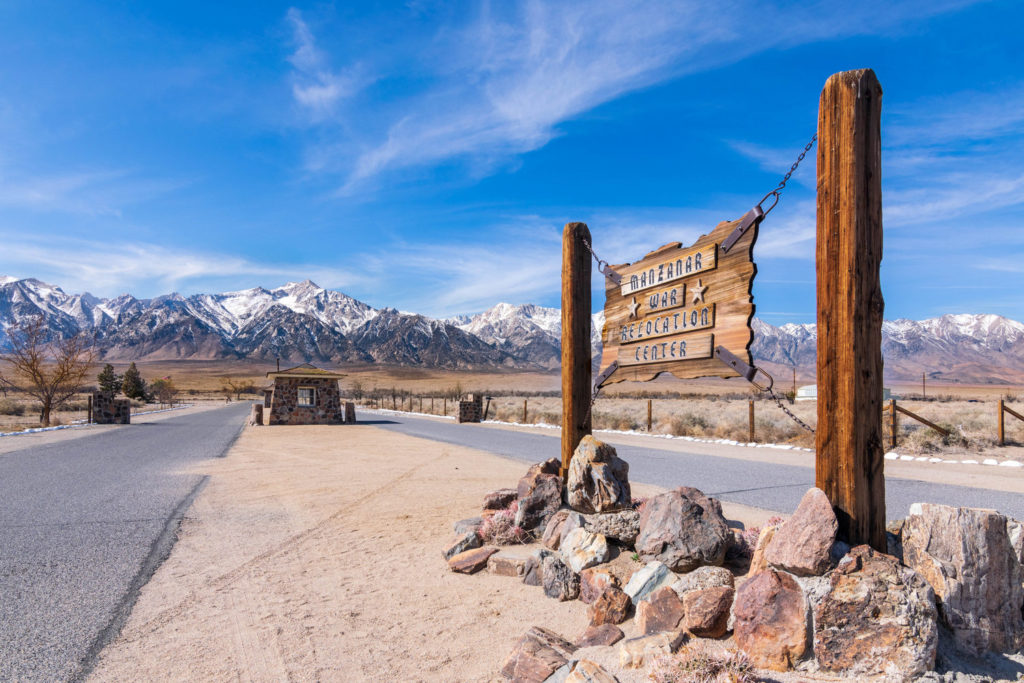
Short History
As Japan dropped bombs on Pearl Harbor, the United States was dragged into WWII; a war this country did not want to be a part of. When our country was attacked, and American soldiers were lost at the hands of Japanese soldiers, President Roosevelt immediately became suspicious of anyone of Japanese descent on US soil. Perhaps they were spies or something worse he imagined. He signed an Executive Order to establish “military zones” and round up all Japanese-American citizens or Japanese immigrants (even though they were living here legally). Put them in an isolated area to ensure they could keep a watchful eye on them. They were given only days to gather as much as they could carry in two suitcases before having to leave everything behind.
Ten camps across seven states were created to “house” them. Over 110,000 citizens were relocated, and approximately 10,000 resided at Manzanar. Surrounded by barbed wire fences and watched over by eight guard towers, this really had the feel of a prison. The barracks were very tight quarters, initially with no heat in these extreme weather conditions along the Eastern Sierra range. Early stories told of people waking up covered in sand and freezing due to the high winds sweeping through the numerous holes in the roofs of the barracks.
Today
Entering as a visitor today, you initially see a vast open range of land. 500 acres with just a few buildings and lots of dead brush. You drive past a guard tower and through an opening in the barbed wire fence. The howling, chilling wind is an eerie reminder of what conditions these humans had to endure. As you exit your car, a massive structure stands before you. This mint green building is the only original structure remaining. At that time, this was the camp auditorium, but now serves as the Visitor’s Center.
As we entered, we immediately asked for a Junior Ranger book and sat down to watch the movie presentation. It’s a 20 minute movie that is truly worth seeing. It gives a great foundation of information through many first hand accounts. You can feel their fear, their anger and their frustration through their own words. The photos are poignant as you see young children behind barbed wire; trying to find some sense of normalcy in playing a game of the good ol’ American pastime – baseball.
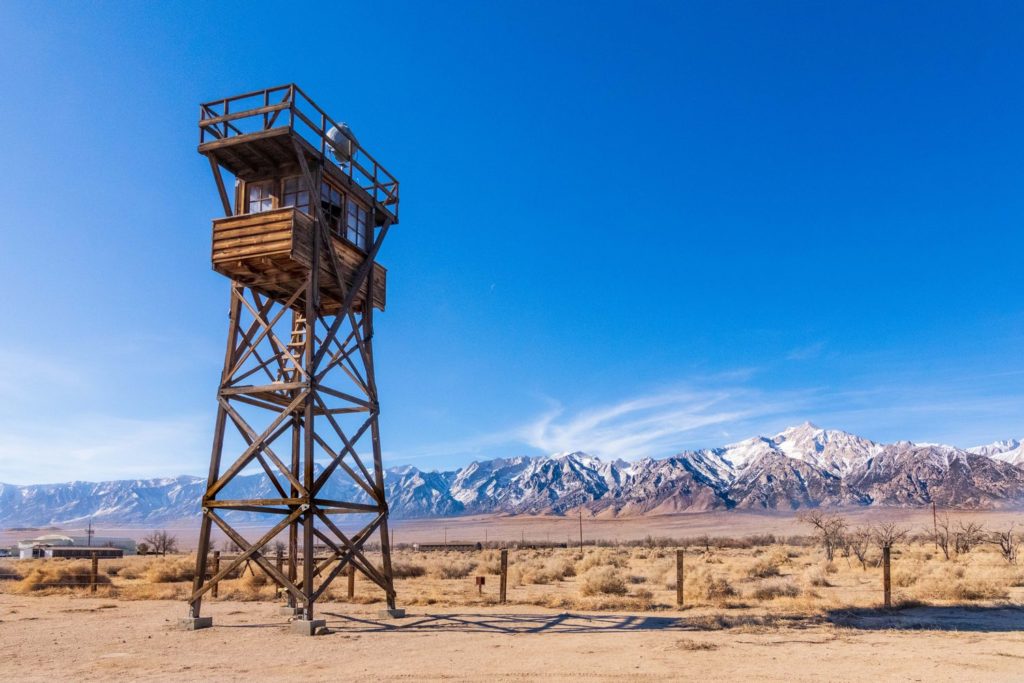
The first page of the Junior Ranger book asks young explorers, if you had two days to pack only ten items to bring with you, what would they be? Powerful. Initially, our youngest named ten of her favorite stuffed animals, but this opened the dialogue for deeper discussion. We talked about how these children didn’t know where they were going or when (or if) they would ever return home. As she reflected, she shifted to more important items such as shoes, clothing, family photos and (one of our favorites) her Junior Ranger banner with her badge collection. She was beginning to understand what an impact this made on these young children who were sent here.
Walking around the museum displays in the Visitor’s Center, you get a glimpse into their lives during these years of internment. Medical services were extremely limited causing illness to run rampant. Privacy was completely lost as strangers were forced to sit next to each other on side by side toilets. Mattresses were bags filled with hay, which the internees had to fill themselves. A toy “library” was created by pooling together any toys that were brought to the camp as a way to address the fact that in the rush to relocate. Many children didn’t manage to bring anything to play with. You’ll find that your heart aches in reading the personal stories throughout.
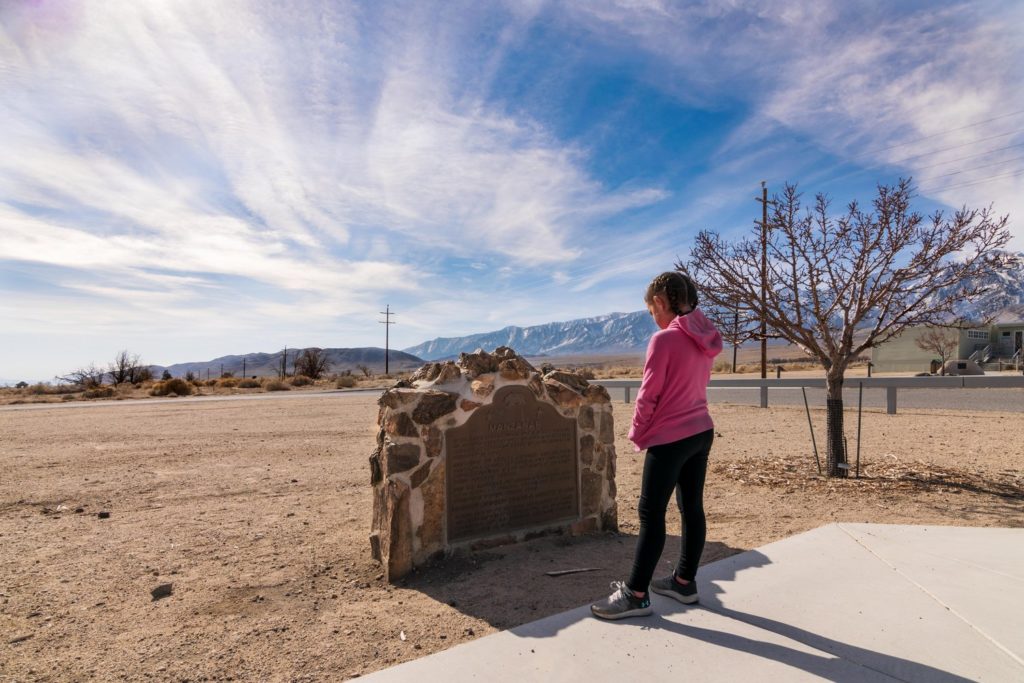
Manzanar internees were predominantly from the Los Angeles area and had adapted to moderate coastal weather and temperature patterns. Ranging in age from infants to the elderly, very few of the internees were accustomed to the harsh weather conditions of the Eastern Sierra area. The internees suffered through freezing winters and endured searing summer temperatures that reached over 110 degrees in the summer.
Auto/Walking Tour
As it was getting later in the day, we headed out for the auto/walking tour to explore the grounds of Manzanar National Historic Site. At the first stop, you’re faced with a dirt basketball court with barbed wire fencing as a back wall. Aside from the danger of having this where children played, it was a stark reminder that this place was not friendly. The National Park Service provided a box of semi-inflated basketballs with which our kids enjoyed shooting some hoops. They quickly realized how much more difficult it was with the cold blowing winds.
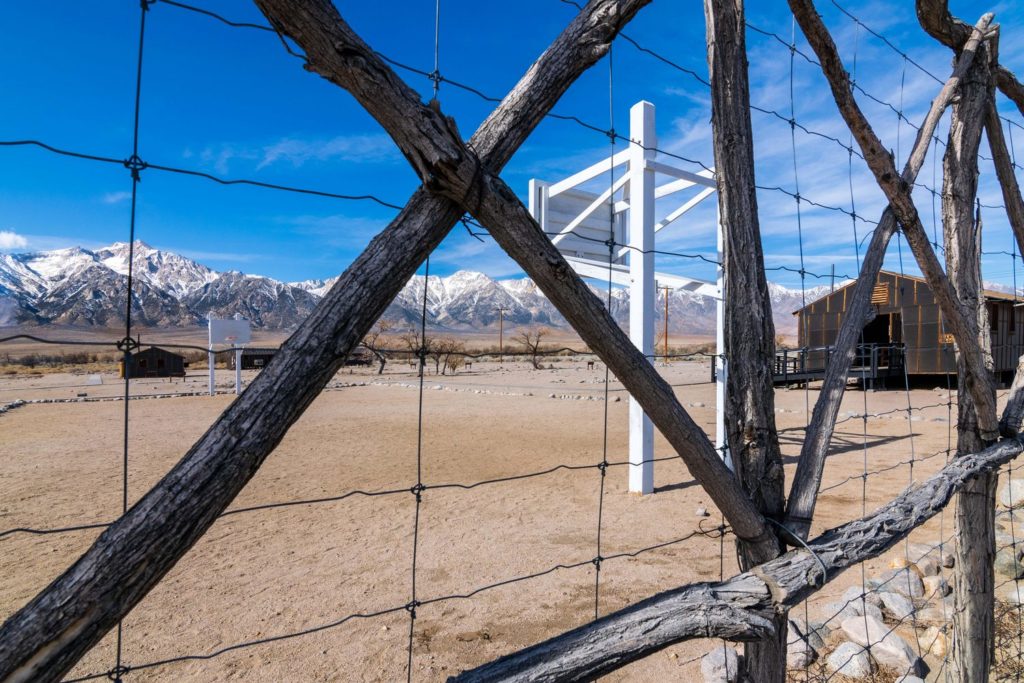
Next to the basketball court were two reconstructed barracks remodeled to look as it was when the camp existed. The bare-boned structures were outfitted with metal bed frames, some with mattresses (which came later in the camp) and some with straw hay “pads”. Suitcases lined up meticulously with shoes next to the bed was a powerful reminder that these were proud people who, no matter their circumstances, still carried themselves with dignity.
Most of the barracks are gone, only the concrete foundation slabs remain demonstrating how close and compact these quarters were. Internees were arranged in “blocks” which consisted of a group of barracks. This resulted in each block having a closer “neighborhood” feeling among the families. The concrete slabs are all that remain of many of these barracks.
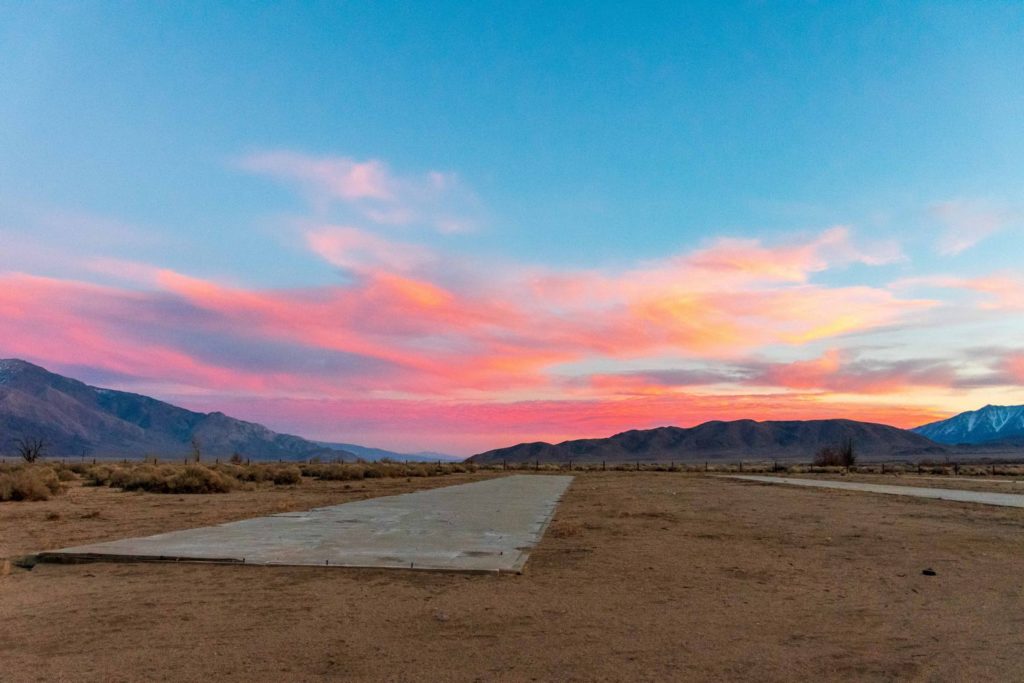
We hopped back in the car to continue the auto tour and observed that throughout the camp there are signs denoting the former location of key buildings and spaces. One particularly interesting place that we explored was the Merritt Park garden. One of many gardens created, this was the largest and most beautiful. Built by the men and women at the camp, this was a place where they could feel an escape from the reality of where they lived. It was a place to come together, a place for children to play and families to connect. After the camp closed in 1945, many of the gardens were bulldozed and any remnants were buried under the fast blowing sand. Later, in 1993, the NPS did an archaeological study that rediscovered these gardens, excavated and restored them. While only rocks and wood bridges remain, visitors can sit on the benches and imagine the beauty that once helped these people escape even if only for a moment.
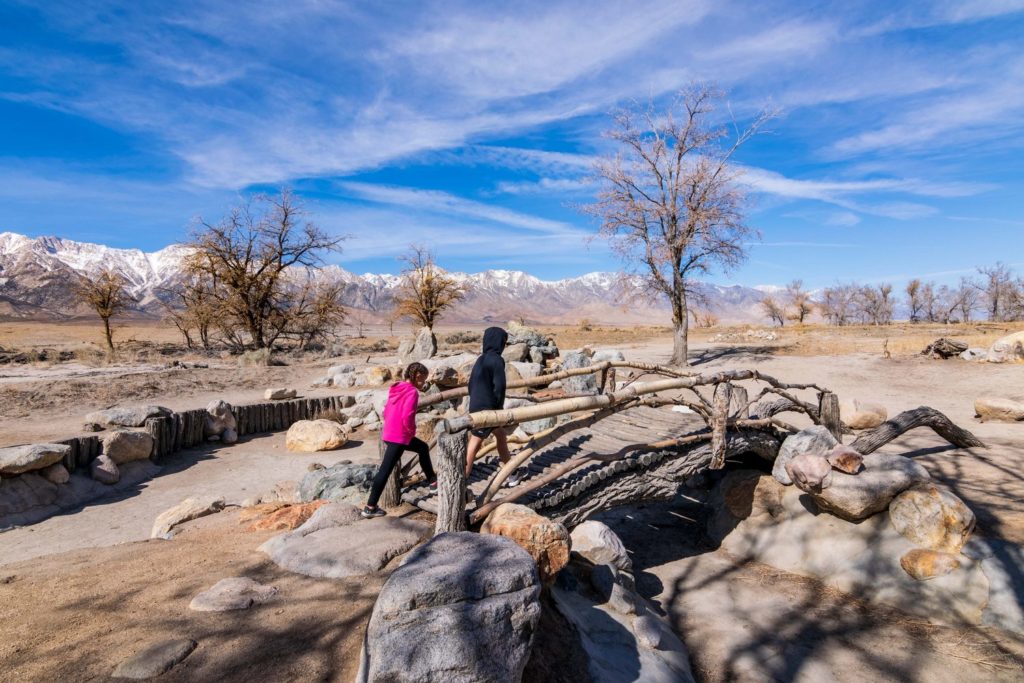
A little farther around the auto tour takes you to the most distant point at the back of the site. There standing isolated and back-dropped by the spectacular Eastern Sierra mountains, is a tall ivory memorial etched with black Japanese lettering meaning soul consoling tower. This marks the cemetery for Manzanar. A rope fence wraps the memorial on 3 sides with thousands of origami cranes draping on each stoop. You can walk around and touch the memorial – you feel the power of this stone marker. Upon closer observation, you might see small trinkets, stones, gems, coins or even photos. We learned that this tradition of leaving something at a gravestone is a part of many cultures. To each side of the memorial are additional “grave sites” outlined in stones with a tall wooden pillar. This space is powerful and peaceful. Truly a place to connect and celebrate life.
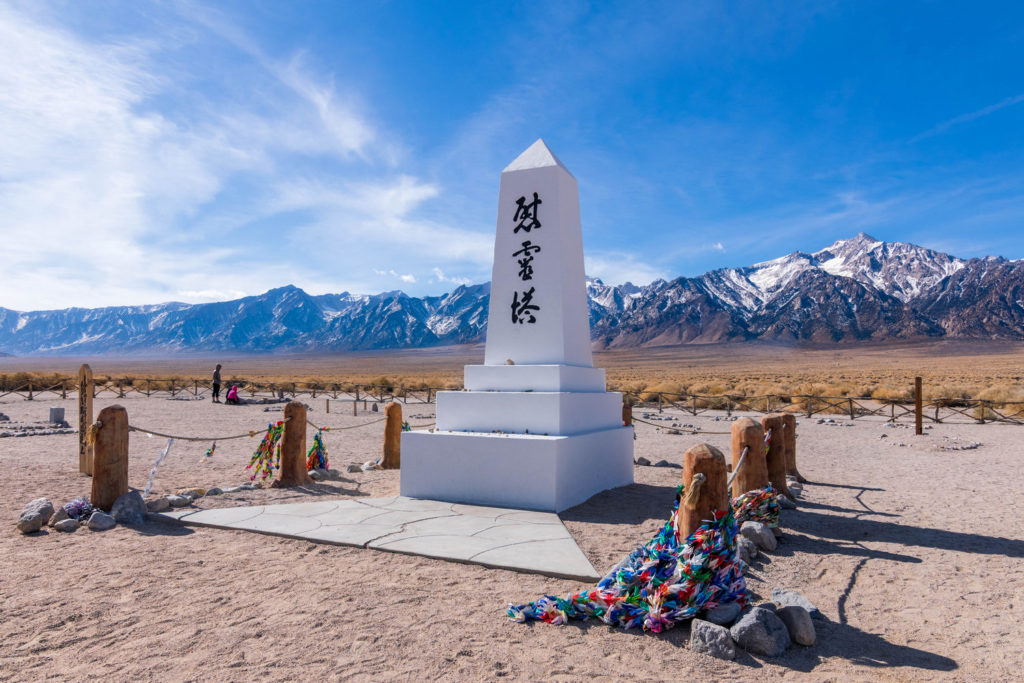
Beyond the memorial, you continue the drive back towards the front of the camp. Vast lands that were once covered with very tight barracks are now dotted with empty concrete slabs, occasional upstanding plumbing pipes and dead trees.
We didn’t know in advance how this visit would affect us, but came to find it was incredibly powerful and eye-opening. The NPS did a great job allowing the stories of the internees to speak for themselves through actual audio footage, photographs and re-creations. The exhibits in the Visitor’s Center are well-done and very informative. We suggest you take the time to digest as much as you can. It’s worth mentioning again, that aside from the main Visitor’s Center, the fencing, guard towers, and buildings are either re-creations or similar building types imported from other government sites. It turns out, the US Government sold off the building materials to try and recover some of the money they spent to detain these citizens.
While many of the messages and lessons were too dark for our children to truly understand, they walked away from Manzanar National Historic Site with the most powerful message of all… WE MUST NOT ALLOW THIS TO HAPPEN AGAIN.
Some additional resources:
- National Park Service – Manzanar NHS
- National Park Foundation – Manzanar National Historic Site
- Visit Mammoth

